headlamp CHEVROLET KODIAK 2005 User Guide
[x] Cancel search | Manufacturer: CHEVROLET, Model Year: 2005, Model line: KODIAK, Model: CHEVROLET KODIAK 2005Pages: 374, PDF Size: 5.46 MB
Page 203 of 374
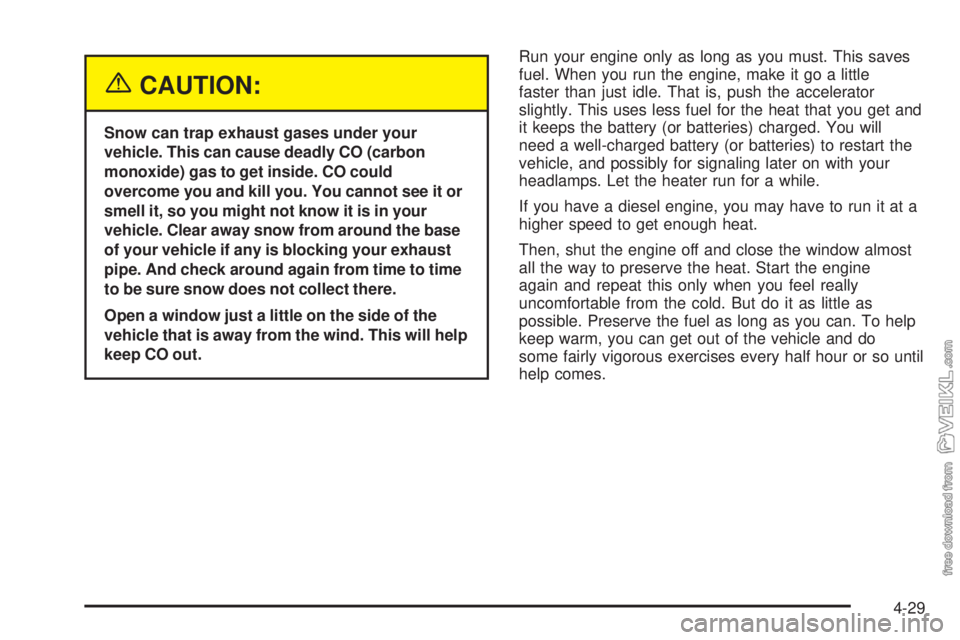
{CAUTION:
Snow can trap exhaust gases under your
vehicle. This can cause deadly CO (carbon
monoxide) gas to get inside. CO could
overcome you and kill you. You cannot see it or
smell it, so you might not know it is in your
vehicle. Clear away snow from around the base
of your vehicle if any is blocking your exhaust
pipe. And check around again from time to time
to be sure snow does not collect there.
Open a window just a little on the side of the
vehicle that is away from the wind. This will help
keep CO out.Run your engine only as long as you must. This saves
fuel. When you run the engine, make it go a little
faster than just idle. That is, push the accelerator
slightly. This uses less fuel for the heat that you get and
it keeps the battery (or batteries) charged. You will
need a well-charged battery (or batteries) to restart the
vehicle, and possibly for signaling later on with your
headlamps. Let the heater run for a while.
If you have a diesel engine, you may have to run it at a
higher speed to get enough heat.
Then, shut the engine off and close the window almost
all the way to preserve the heat. Start the engine
again and repeat this only when you feel really
uncomfortable from the cold. But do it as little as
possible. Preserve the fuel as long as you can. To help
keep warm, you can get out of the vehicle and do
some fairly vigorous exercises every half hour or so until
help comes.
4-29
Page 214 of 374

Other Service Items........................................5-66
Fuel Filter....................................................5-66
Primary Fuel Filter and Water Separator..........5-67
Secondary Fuel Filter and Water Separator/
Heater (Caterpillar
®Diesel)..........................5-68
Automatic Ether Injection System
(Caterpillar
®Diesel)....................................5-68
Front Wheel Bearings with Oil-Filled Hubs........5-69
Air Conditioning System.................................5-70
Tires..............................................................5-70
Inflation - Tire Pressure.................................5-71
Wheel Loading.............................................5-71
Dual Tire Operation.......................................5-72
When It Is Time for New Tires.......................5-72
Wheel Alignment and Tire Balance..................5-73
Tightening the Wheel Nuts.............................5-73
Wheel Replacement......................................5-77
If a Tire Goes Flat........................................5-78
Appearance Care............................................5-79
Cleaning the Inside of Your Vehicle.................5-80
Fabric/Carpet...............................................5-81
Instrument Panel, Vinyl, and Other
Plastic Surfaces........................................5-82
Care of Safety Belts......................................5-82
Weatherstrips...............................................5-82Washing Your Vehicle...................................5-83
Cleaning Exterior Lamps/Lenses.....................5-83
Finish Care..................................................5-83
Windshield and Wiper Blades.........................5-84
Aluminum or Chrome-Plated Wheels................5-84
Tires...........................................................5-85
Sheet Metal Damage.....................................5-85
Finish Damage.............................................5-85
Underbody Maintenance................................5-85
Chemical Paint Spotting.................................5-85
Vehicle Identi�cation......................................5-87
Vehicle Identification Number (VIN).................5-87
Service Statement.........................................5-87
Service Parts Identification Label.....................5-88
Electrical System............................................5-88
Add-On Electrical Equipment..........................5-88
Headlamp Wiring..........................................5-88
Windshield Wiper Fuses................................5-88
Fusible Links................................................5-89
Power Windows and Other Power Options.......5-89
Fuses and Circuit Breakers............................5-89
Instrument Panel Fuse Block..........................5-89
Underhood Fuse Block..................................5-92
Capacities and Speci�cations..........................5-95
Normal Maintenance Replacement Parts.........5-100
Section 5 Service and Appearance Care
5-2
Page 289 of 374
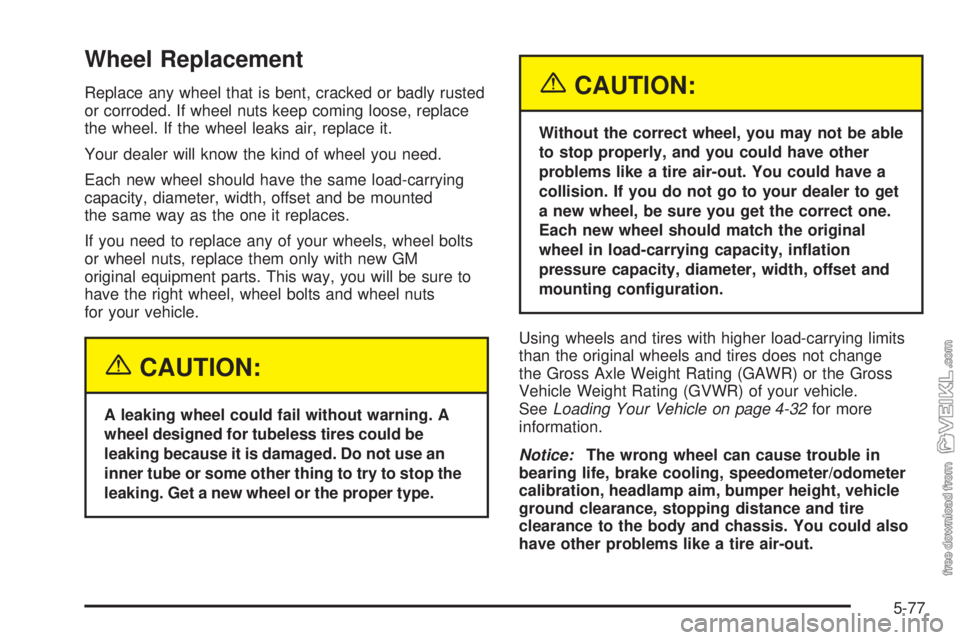
Wheel Replacement
Replace any wheel that is bent, cracked or badly rusted
or corroded. If wheel nuts keep coming loose, replace
the wheel. If the wheel leaks air, replace it.
Your dealer will know the kind of wheel you need.
Each new wheel should have the same load-carrying
capacity, diameter, width, offset and be mounted
the same way as the one it replaces.
If you need to replace any of your wheels, wheel bolts
or wheel nuts, replace them only with new GM
original equipment parts. This way, you will be sure to
have the right wheel, wheel bolts and wheel nuts
for your vehicle.
{CAUTION:
A leaking wheel could fail without warning. A
wheel designed for tubeless tires could be
leaking because it is damaged. Do not use an
inner tube or some other thing to try to stop the
leaking. Get a new wheel or the proper type.
{CAUTION:
Without the correct wheel, you may not be able
to stop properly, and you could have other
problems like a tire air-out. You could have a
collision. If you do not go to your dealer to get
a new wheel, be sure you get the correct one.
Each new wheel should match the original
wheel in load-carrying capacity, in�ation
pressure capacity, diameter, width, offset and
mounting con�guration.
Using wheels and tires with higher load-carrying limits
than the original wheels and tires does not change
the Gross Axle Weight Rating (GAWR) or the Gross
Vehicle Weight Rating (GVWR) of your vehicle.
SeeLoading Your Vehicle on page 4-32for more
information.
Notice:The wrong wheel can cause trouble in
bearing life, brake cooling, speedometer/odometer
calibration, headlamp aim, bumper height, vehicle
ground clearance, stopping distance and tire
clearance to the body and chassis. You could also
have other problems like a tire air-out.
5-77
Page 300 of 374
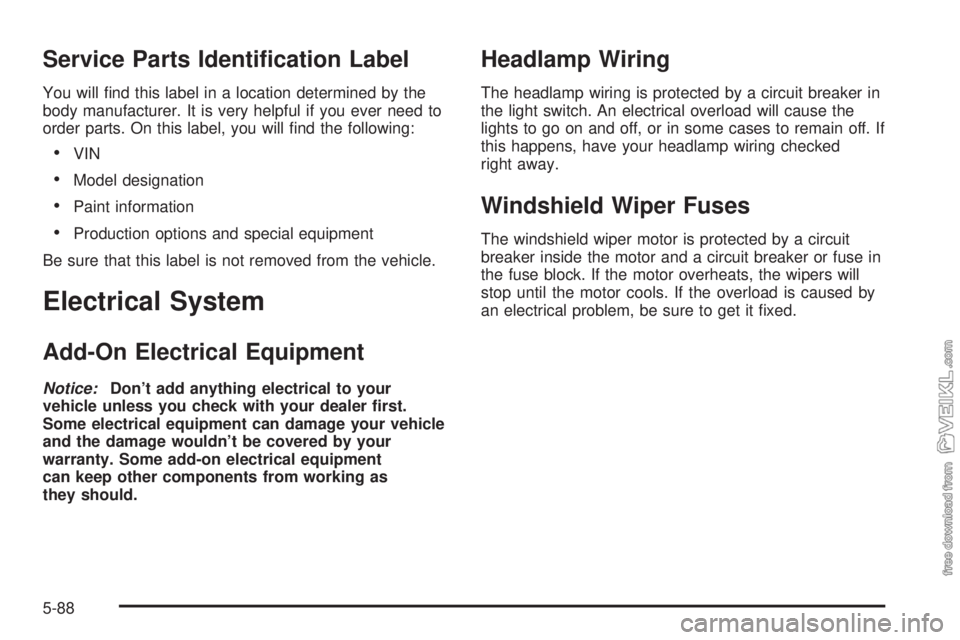
Service Parts Identi�cation Label
You will find this label in a location determined by the
body manufacturer. It is very helpful if you ever need to
order parts. On this label, you will find the following:
•VIN
•Model designation
•Paint information
•Production options and special equipment
Be sure that this label is not removed from the vehicle.
Electrical System
Add-On Electrical Equipment
Notice:Don’t add anything electrical to your
vehicle unless you check with your dealer �rst.
Some electrical equipment can damage your vehicle
and the damage wouldn’t be covered by your
warranty. Some add-on electrical equipment
can keep other components from working as
they should.
Headlamp Wiring
The headlamp wiring is protected by a circuit breaker in
the light switch. An electrical overload will cause the
lights to go on and off, or in some cases to remain off. If
this happens, have your headlamp wiring checked
right away.
Windshield Wiper Fuses
The windshield wiper motor is protected by a circuit
breaker inside the motor and a circuit breaker or fuse in
the fuse block. If the motor overheats, the wipers will
stop until the motor cools. If the overload is caused by
an electrical problem, be sure to get it fixed.
5-88
Page 306 of 374
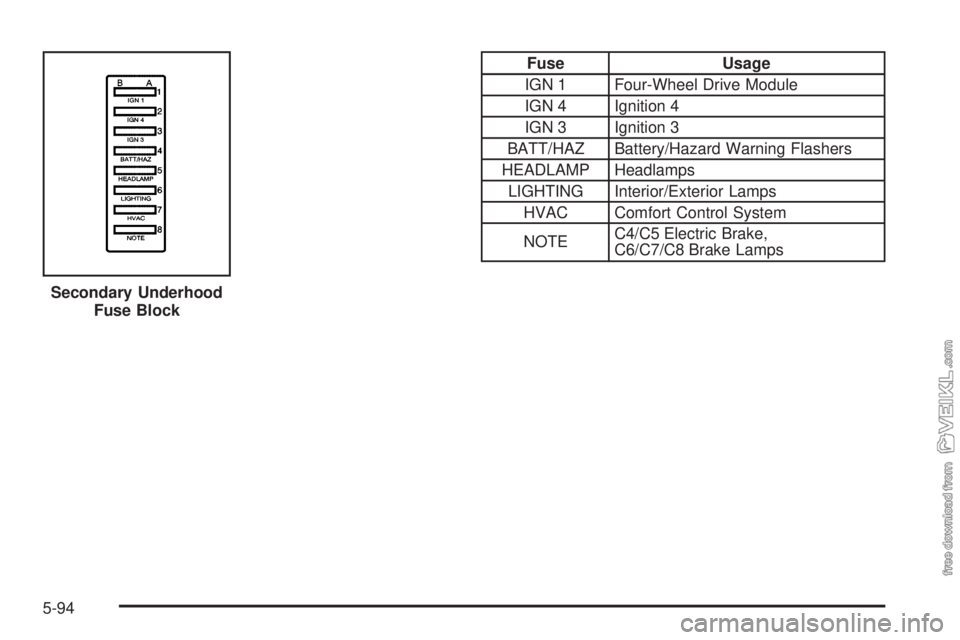
Fuse Usage
IGN 1 Four-Wheel Drive Module
IGN 4 Ignition 4
IGN 3 Ignition 3
BATT/HAZ Battery/Hazard Warning Flashers
HEADLAMP Headlamps
LIGHTING Interior/Exterior Lamps
HVAC Comfort Control System
NOTEC4/C5 Electric Brake,
C6/C7/C8 Brake Lamps
Secondary Underhood
Fuse Block
5-94
Page 344 of 374
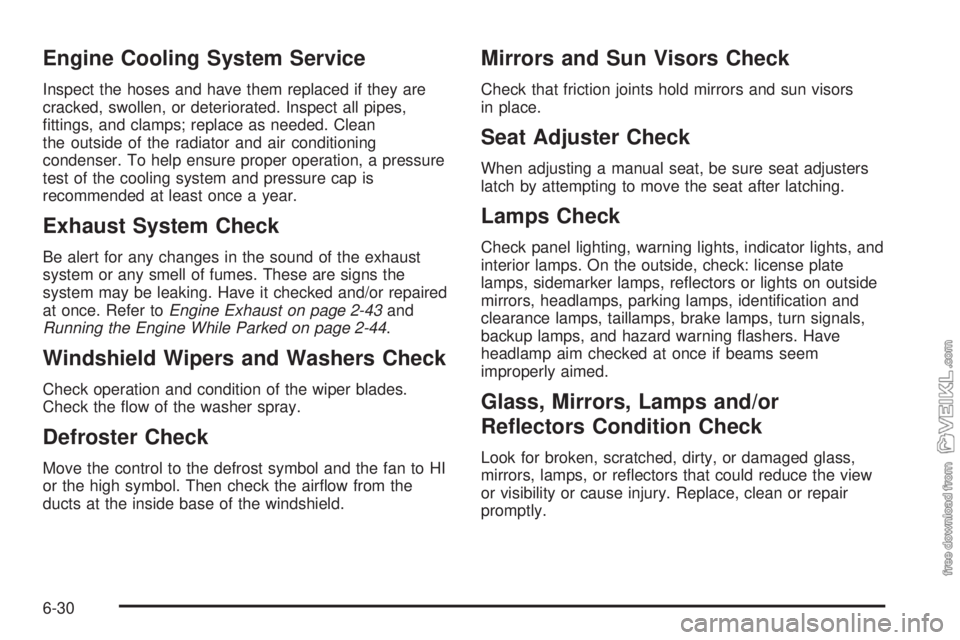
Engine Cooling System Service
Inspect the hoses and have them replaced if they are
cracked, swollen, or deteriorated. Inspect all pipes,
fittings, and clamps; replace as needed. Clean
the outside of the radiator and air conditioning
condenser. To help ensure proper operation, a pressure
test of the cooling system and pressure cap is
recommended at least once a year.
Exhaust System Check
Be alert for any changes in the sound of the exhaust
system or any smell of fumes. These are signs the
system may be leaking. Have it checked and/or repaired
at once. Refer toEngine Exhaust on page 2-43and
Running the Engine While Parked on page 2-44.
Windshield Wipers and Washers Check
Check operation and condition of the wiper blades.
Check the flow of the washer spray.
Defroster Check
Move the control to the defrost symbol and the fan to HI
or the high symbol. Then check the airflow from the
ducts at the inside base of the windshield.
Mirrors and Sun Visors Check
Check that friction joints hold mirrors and sun visors
in place.
Seat Adjuster Check
When adjusting a manual seat, be sure seat adjusters
latch by attempting to move the seat after latching.
Lamps Check
Check panel lighting, warning lights, indicator lights, and
interior lamps. On the outside, check: license plate
lamps, sidemarker lamps, reflectors or lights on outside
mirrors, headlamps, parking lamps, identification and
clearance lamps, taillamps, brake lamps, turn signals,
backup lamps, and hazard warning flashers. Have
headlamp aim checked at once if beams seem
improperly aimed.
Glass, Mirrors, Lamps and/or
Re�ectors Condition Check
Look for broken, scratched, dirty, or damaged glass,
mirrors, lamps, or reflectors that could reduce the view
or visibility or cause injury. Replace, clean or repair
promptly.
6-30
Page 365 of 374
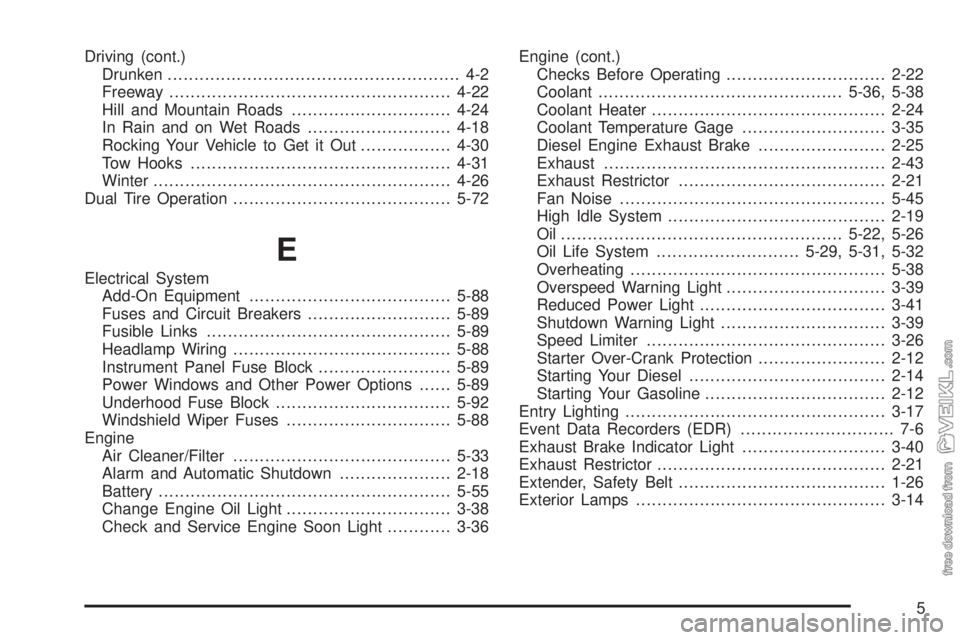
Driving (cont.)
Drunken....................................................... 4-2
Freeway.....................................................4-22
Hill and Mountain Roads..............................4-24
In Rain and on Wet Roads...........................4-18
Rocking Your Vehicle to Get it Out.................4-30
Tow Hooks.................................................4-31
Winter........................................................4-26
Dual Tire Operation.........................................5-72
E
Electrical System
Add-On Equipment......................................5-88
Fuses and Circuit Breakers...........................5-89
Fusible Links..............................................5-89
Headlamp Wiring.........................................5-88
Instrument Panel Fuse Block.........................5-89
Power Windows and Other Power Options......5-89
Underhood Fuse Block.................................5-92
Windshield Wiper Fuses...............................5-88
Engine
Air Cleaner/Filter.........................................5-33
Alarm and Automatic Shutdown.....................2-18
Battery.......................................................5-55
Change Engine Oil Light...............................3-38
Check and Service Engine Soon Light............3-36Engine (cont.)
Checks Before Operating..............................2-22
Coolant..............................................5-36, 5-38
Coolant Heater............................................2-24
Coolant Temperature Gage...........................3-35
Diesel Engine Exhaust Brake........................2-25
Exhaust.....................................................2-43
Exhaust Restrictor.......................................2-21
Fan Noise..................................................5-45
High Idle System.........................................2-19
Oil .....................................................5-22, 5-26
Oil Life System...........................5-29, 5-31, 5-32
Overheating................................................5-38
Overspeed Warning Light..............................3-39
Reduced Power Light...................................3-41
Shutdown Warning Light...............................3-39
Speed Limiter.............................................3-26
Starter Over-Crank Protection........................2-12
Starting Your Diesel.....................................2-14
Starting Your Gasoline..................................2-12
Entry Lighting.................................................3-17
Event Data Recorders (EDR)............................. 7-6
Exhaust Brake Indicator Light...........................3-40
Exhaust Restrictor...........................................2-21
Extender, Safety Belt.......................................1-26
Exterior Lamps...............................................3-14
5
Page 367 of 374
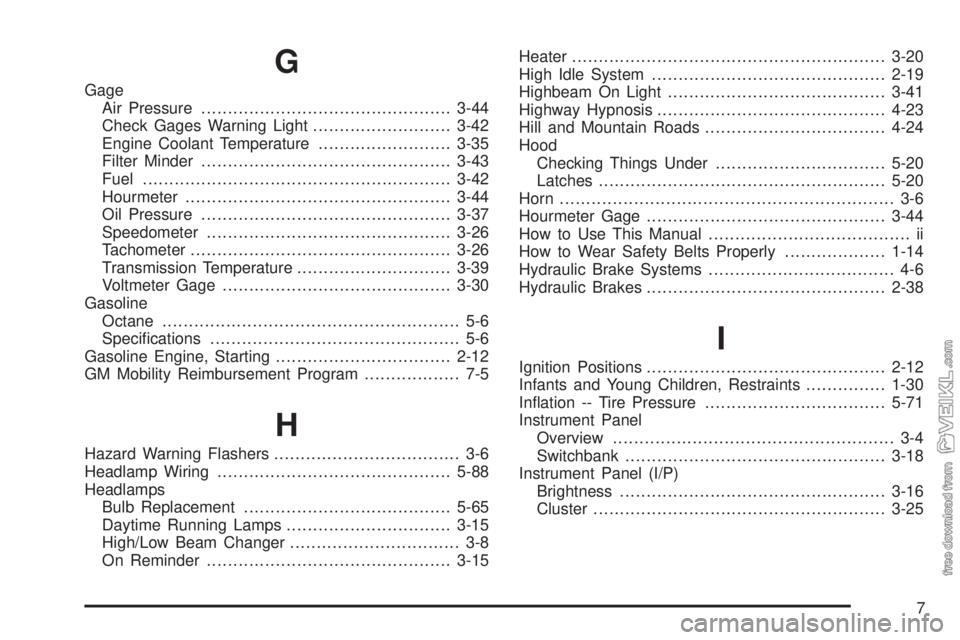
G
Gage
Air Pressure...............................................3-44
Check Gages Warning Light..........................3-42
Engine Coolant Temperature.........................3-35
Filter Minder...............................................3-43
Fuel..........................................................3-42
Hourmeter..................................................3-44
Oil Pressure...............................................3-37
Speedometer..............................................3-26
Tachometer.................................................3-26
Transmission Temperature.............................3-39
Voltmeter Gage...........................................3-30
Gasoline
Octane........................................................ 5-6
Specifications............................................... 5-6
Gasoline Engine, Starting.................................2-12
GM Mobility Reimbursement Program.................. 7-5
H
Hazard Warning Flashers................................... 3-6
Headlamp Wiring............................................5-88
Headlamps
Bulb Replacement.......................................5-65
Daytime Running Lamps...............................3-15
High/Low Beam Changer................................ 3-8
On Reminder..............................................3-15Heater...........................................................3-20
High Idle System............................................2-19
Highbeam On Light.........................................3-41
Highway Hypnosis...........................................4-23
Hill and Mountain Roads..................................4-24
Hood
Checking Things Under................................5-20
Latches......................................................5-20
Horn............................................................... 3-6
Hourmeter Gage.............................................3-44
How to Use This Manual...................................... ii
How to Wear Safety Belts Properly...................1-14
Hydraulic Brake Systems................................... 4-6
Hydraulic Brakes.............................................2-38
I
Ignition Positions.............................................2-12
Infants and Young Children, Restraints...............1-30
Inflation -- Tire Pressure..................................5-71
Instrument Panel
Overview..................................................... 3-4
Switchbank.................................................3-18
Instrument Panel (I/P)
Brightness..................................................3-16
Cluster.......................................................3-25
7